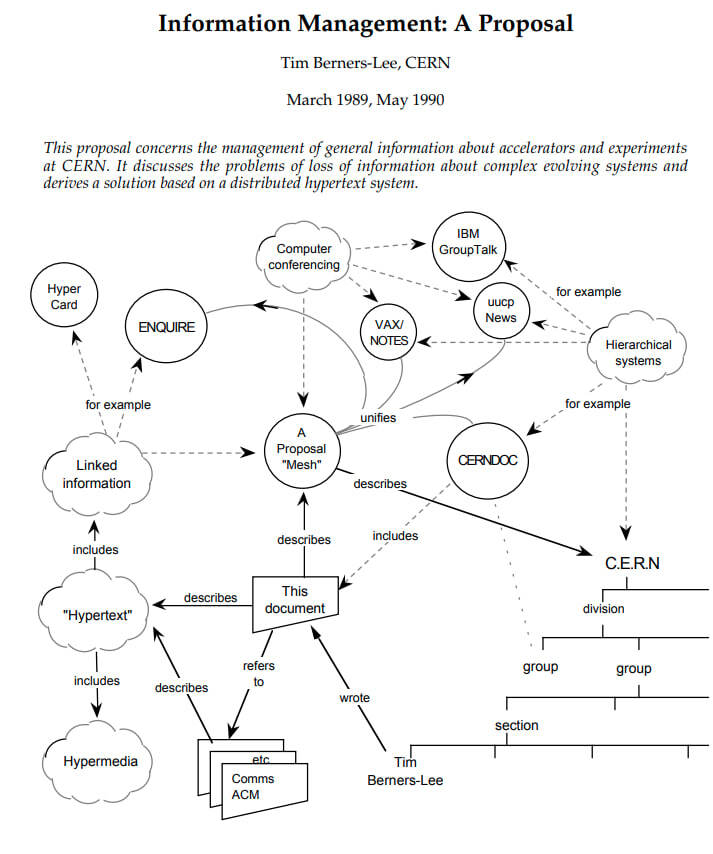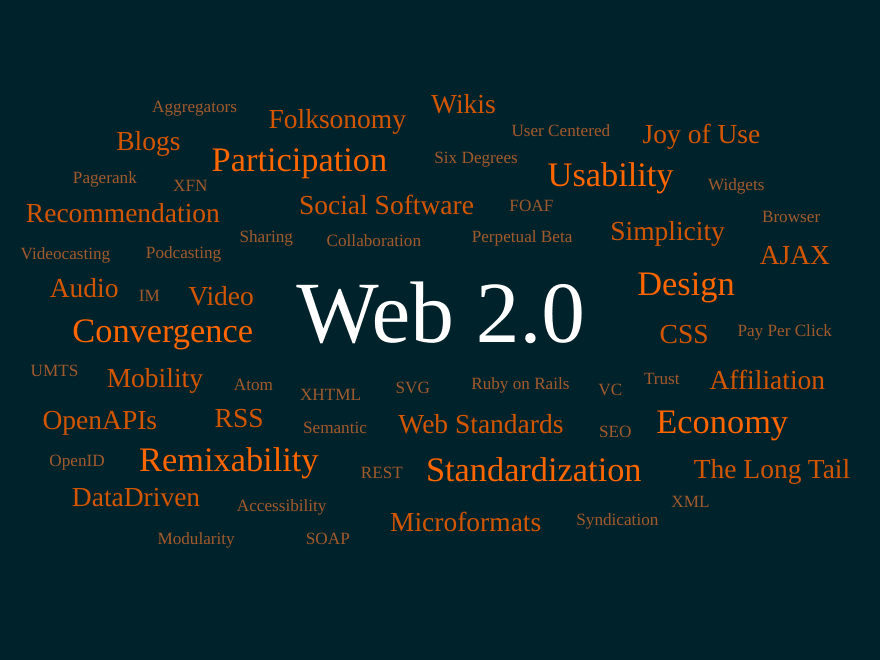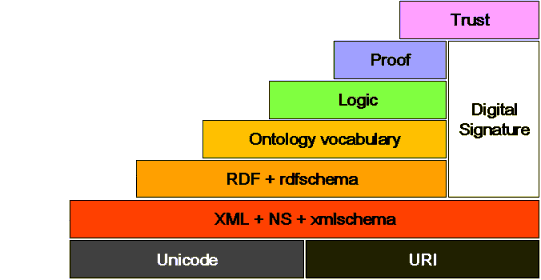Web 1.0
The web was proposed in 1989, by Tim Berners-Lee but had been conceived decades earlier. The proposal was not read for a full year, and, after that, allowed as a side-project with the infamous words, "vague, but exciting".
The first version added hyperlinks to existing browser technology. Bundled together were:
- HTTP and the first server
- the first web browser, which was also an editor
- HTML which was based on SGML
Importantly a new type of variable was created, the hyperlink, originally the UDI (Universal Document Identifier). This was later standardized as the URI, with an intent to go beyond just documents to describe Things as well.
Web 1.0 was in competition with Gopher at the time, and Gopher was winning. However, there was a rumour that Gopher might charge some royalties on their protocol, say, to enterprise customers, and with that, the people flocked to the web and made it take off as a grass roots movement.
HTTP was a formal specification in 1997 a full 8 years later, and the architecture of the world wide web was published in 2004, 7 years after that.
Web 2.0
As the web grew as a system, businesses started to spring up around it. A product was a browser called Mosaic, made by Marc Andreessen. While Mosiac added multi media, it also removed the editing functionality in the original browser, a tragic loss.
Without editing built in, the web needed central servers to allow user generated content. These servers grew in time to become giants. A technology added on this was AJAX, which allowed browsers to interact with servers asynchronously to generate richer applications and realtime updates.
This system of greater usability was branded "Web 2.0", popularized by Tim O'Reilly. It was not a formal upgrade of the web, so considered somewhat cheeky by some, the inventor of the web calling the term "jargon". Jargon it is, but the term stuck, and the web did go to a next level, adding important things like search, commerce, and the social web.
With the increased centralization of servers came other problems, such as pervasive tracking, monopolistic effects, censorship and information engineering.
Web 3.0
Web 3.0 was a term coined by Tim Berners-Lee, to represent a radical new idea, which allowed both data and documents to be denoted, on the web. This is of course a radical old idea which was in the web 1.0 proposal, a so-called "semantic web", but with the name 2.0 already co-opted, Tim decided to call it web 3.0.
The was formalized in the RDF (resource definition framework) which made extensive use of XML. Later it was renamed Linked Data, sometimes called the web of data. This has been popularized by schema.org which allows commonly used terms to be put in web pages, allowing easier search, and link previews.
Berners-Lee continues to work on a project called Solid, which stands for "Social Linked Data" (a term I coined in 2012), with the aim of making Linked Data more social, and benefiting from same usability upgrades and lessons learned from "Web 2.0"
The full web 3.0 stack is standardized at the w3c, though has grown over time, leading to a somewhat complex system, and steep learning curve for new developers.
A note on the deceptively named web3. This was an attempt by VCs (including Marc Andreessen again) and others to co-opt the web brand. The main aim was an affinity scam to sell tokens to the unsuspecting public. The issue is that it is not the web at all. In this case Berners-Lee did speak out against it:
https://www.cnbc.com/2022/11/04/web-inventor-tim-berners-lee-wants-us-to-ignore-web3.html
Towards Web 4.0
The first 3 "versions" of the web work well enough. However, the web itself is ephemeral. The average age of a link is 100 days. And there is no good mechanism at web scale to ensure the integrity or version control of information on the web. A possible approach to the next version of the web would be towards a Temporal Web. I wrote a post about this here:
https://lists.w3.org/Archives/Public/public-rww/2021May/0006.html
A significant innovation in recent times is that of Bitcoin, which is a web scale timestamp server. It orders records (blocks) in time, robustly and securely, creating a permanent record. It also, for the first time in history, creates a global currency that is strongly resistant to money printing by fiat.
These two systems working together could create a robust temporal backbone to the web, allowing commerce without rent seeking, and creating whole new business models that are more decentralized, and act in the interests of the users, competing with each other with better services, rather than, serving privacy intrusive monopolies.
Web 5.0
What web 5.0 will look like, nobody knows. However the aim of the original proposal was to have both humans and machines working together. A semantic web was needed for that, to make it easier for machines to participate. Although machines are often censored or blocked on the large platforms, or, even worse, act with perverse incentives to spam users with adverts, noisy information and propaganda.
One guess about web 5.0 could be a web of machine agents, virtual assistants, working together with people to act in the interests of people. This builds on a Temporal web as machines can then evolve over time and the best ones will emerge, in an evolutionary way. Artificial Intelligence can further be folded into the system to optimize its utility to humanity.
A note on web5: This was an earnest attempt to push back on web3 and remove some of the more corrupt aspects, such as copious use of money printing. It has some alignment with the web, but it is not web 5.0, however, I hope it produces something interesting. Never fight an affinity scam with an affinity scam.
IMHO a promising project in this area is Nostr. It reuses the websockets standard to relay information from one user to another which is signed. Importantly, it is grass roots, as the original web was, has already integrated fast cheap payments, with bitcoin and the lightning network in many apps. Unlike the semantic web, it has a very easy developer experience which has seen high uptake from developers. Additionally, the tagging system allows integration with time chains paving a cow path for a temporal web, and then perhaps humans and agents co existing for mutual benefit. We are still early, but time will tell how the web evolves.
Opinions are the views of the author











Top comments (2)
Thank you for your writing
Excellent article.